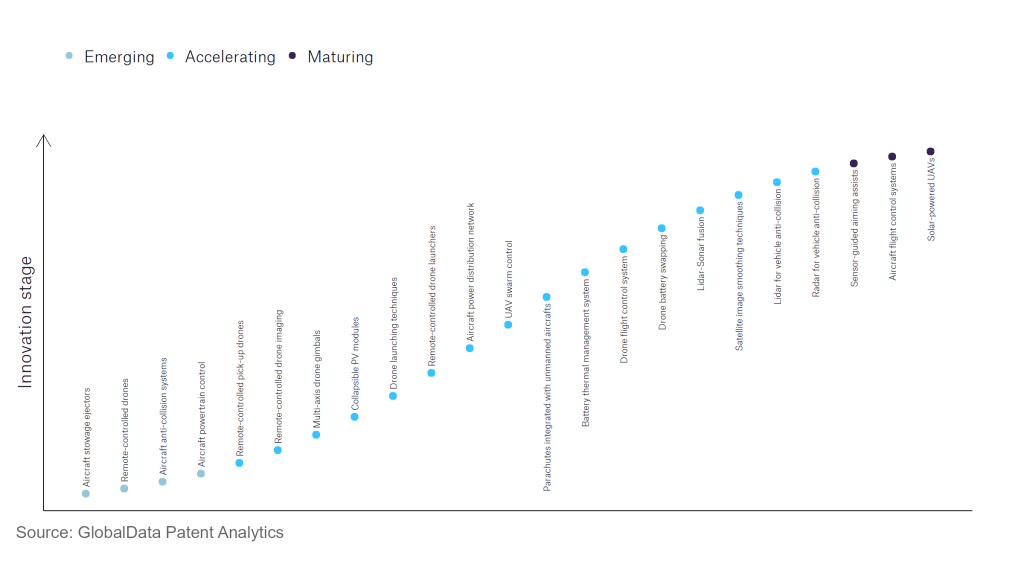The aerospace and defence industry continues to be a hotbed of innovation, with activity driven by the pressing need for modernisation and the growing importance of emerging technologies such as artificial intelligence and unmanned systems. In the last three years alone, there have been over 174,000 patents filed and granted in the aerospace and defence industry, according to GlobalData’s report on Internet of Things in Aerospace, Defence & Security: Drone launching techniques. Buy the report here.
However, not all innovations are equal and nor do they follow a constant upward trend. Instead, their evolution takes the form of an S-shaped curve that reflects their typical lifecycle from early emergence to accelerating adoption, before finally stabilising and reaching maturity.
Identifying where a particular innovation is on this journey, especially those that are in the emerging and accelerating stages, is essential for understanding their current level of adoption and the likely future trajectory and impact they will have.
180+ innovations will shape the aerospace and defence industry
According to GlobalData’s Technology Foresights, which plots the S-curve for the aerospace and defence industry using innovation intensity models built on over 262,000 patents, there are 180+ innovation areas that will shape the future of the industry.
Within the emerging innovation stage, aircraft powertrain controls, remote controlled drones, and aircraft anti-collision systems are disruptive technologies that are in the early stages of application and should be tracked closely. UAV swarm control, lidar for vehicle anti-collision, and satellite image smoothing techniques are some of the accelerating innovation areas, where adoption has been steadily increasing.
Innovation S-curve for Internet of Things in the aerospace and defence industry

Drone launching techniques is a key innovation area in Internet of Things
Modern UAV platforms come in a range of different airframes and sizes, which in some cases require specialised technology and techniques to become airborne. Certain smaller fixed-wing UAVs are launched from pneumatic, hydraulic or bungee-assisted catapults, while larger UAV platforms require runways or advanced catapult systems such as those on modern aircraft carriers.
GlobalData’s analysis also uncovers the companies at the forefront of each innovation area and assesses the potential reach and impact of their patenting activity across different applications and geographies. According to GlobalData, there are 40 companies, spanning technology vendors, established aerospace and defence companies, and up-and-coming start-ups engaged in the development and application of drone launching techniques.
Key players in drone launching techniques – a disruptive innovation in the aerospace and defence industry
‘Application diversity’ measures the number of different applications identified for each relevant patent and broadly splits companies into either ‘niche’ or ‘diversified’ innovators.
‘Geographic reach’ refers to the number of different countries each relevant patent is registered in and reflects the breadth of geographic application intended, ranging from ‘global’ to ‘local’.
Patent volumes related to drone launching techniques
Source: GlobalData Patent Analytics
SZ DJI Technology has filed the largest number of patents in this domain over the last several years. SZ DJI Technology produces a range of commercial drones for the consumer, agricultural and industrial sectors. Most of SZ DJI’s launching technologies were developed to enable small handheld drones to launch in various conditions and environments more reliably. The second most prominent patent applicant in this domain is KDDI, which specialises in the development of small commercial drones which can be utilised for inspecting infrastructure and facilities. KDDI’s recent work in this field includes smart drone platforms which facilitate launches.
In terms of application diversity, KDDI is the top company due to the variety of industries its drones can be utilised in, and Hitachi is in second place. In terms of geographic spread, SZ DJI Technology is first, followed by KDDI.
To further understand how Internet of Things is disrupting the aerospace and defence industry, access GlobalData’s latest thematic research report on Thematic Research - Internet of Military Things.
Data Insights
From

The gold standard of business intelligence.
Blending expert knowledge with cutting-edge technology, GlobalData’s unrivalled proprietary data will enable you to decode what’s happening in your market. You can make better informed decisions and gain a future-proof advantage over your competitors.



